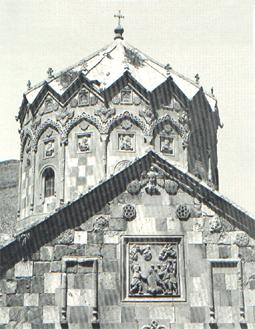HISTORY
The original town of Jugha was situated in present-day Nakhichevan
(currently occupied by Azerbaijan). In the 15-17th centuries it was
an important trade center in Armenia. Merchants of Jugha reached major
trade cities in Austria, France, Italy, Holland, Russia, Egypt, and
Turkey, and port cities in India, Java, Sumatra, Burma, the Philippines
and elsewhere.
Enticed by the wealth of these merchants, in October 1604, over the
ongoing wars between Persian Safavids and Turkish Ottomans, the
retreating army of king of Persia - Shah Abbas I (1587-1629)
entered Jugha and forcefully deported the entire population - more
than three thousand families. The town was then set on fire and
destroyed to its very foundation. People were forcefully marched
south across the river Arax into Persia. Many perished on the way.
The survivors reached the center of the country.

|
The Holy Trinity (1619)
from Nor Jugha by
Hakob of Jugha.
|
Near Spahan, south of the Zandarout River, part of the territory was
given the Jughaites as a royal grant; another part, according to the
terms set up, the Armenians had to buy themselves. The Jughaites drew
up a main layout for the construction of the new town. Within a few
years, the building, creating and trade-loving Jughaites helped to
sprout up this new settlement and continued the age-old culture and
art, the life and demeanor of Hin Jugha and the traditions which had
been taught them for ages.
Instead of historical Jugha, now Armenian chronologists began to mention
Nor Jugha in their works, while the old town, its memories and wounds has
gone down into history, remaining only in the minds and hearts of the people,
like the copper-colored slopes of the surrounding mountains.
Here in the new town some thirty prominent families of Hin Jugha such as
the Lazarians, Safrazians, Shahrimanians, Eminians, Khaltarians, Velidjanians,
Sahratians and others, through their successors and later generations and the

|
Church of Saint Stephen
the protomartyr.
17-18th Centuries. Nor Jugha.
|
immediate leadership of Jughaites commemorated the memorials of their birthplace
Jugha and founded the Amenaprkich majestic monastery and seventeen other churches,
opened schools, erected many palatial mansions, created thousands of fine khachkars,
and many, many other monuments. Based on the traditional development of the old
schools of painting in Hin Jugha, Nakhidjevan, Agoulis and Shorot such talented
painters as Minas, Hovhannes Merkouz, Bogdan Saltanov and others settled here and
achieved fame, whose spheres of creative efforts reached the Moscow palaces and
workshops. In 1647 Hovhannes vardapet founded a printing press there, where numerous
books were published. They established in Nor Jugha and in other important communities,
especially Madras and Calcutta, printing houses where they put out numerous books and
finally, in 1794, the first Armenian periodical "Azdarar" was published in Madras.
In the XVII - XVIII centuries the Jughaites controlled the external trade of Persia
and like their forefathers, had extensive trade tied with a number of European
countries. During that same period, they had even closer relations with Russia.
The current Armenian community of Nor Jugha is composed of their descendents who,
over four centuries have painstakingly kept their culture, language and religion.



